Growing up in America, old was anything over 100 years. Over the last ten+ years I have had to seriously revise my thinking. But nothing has so changed my point of view as this trip, beginning in Spain where we saw early human artifacts dating back 1.3 million years.
Last week we visited four more historic sites just outside of London. The first was Canterbury, an area that has been inhabited since prehistoric times.
Of course, like every country around or near the Mediterranean in the first century, one day the Romans showed up and built their customary grid, theatre, forums and baths. By 597, Canterbury even had the beginnings of its Catholic abbey.
And, of course, about 1000 years later (1534), Henry VIII kicked the Catholics out, appointed the first Archbishop of Canterbury and made Canterbury the Rome of his newly minted Church of England. These days the cathedral and the entire town is a UNESCO World Heritage Site.
Another day we took a train to St. Albans, not a UNESCO site, but like most of Europe, built on Roman ruins. On a walkabout, we came upon the Verulamium Museum and what a pleasant surprise. It's small, but very well curated, and full of treasures from Roman Verulamium and medieval St. Albans upon which the St. Albans of today is built. My sentimental favorites were the tile and potsherds with paw prints left by dogs when the clay was still wet, about a 1,000 years ago. Judging by the deep impression of this dog's paw, I'd say the drawing accompanying the sherd is pretty accurate.
Wikipedia, generally my go-to site for unbiased information, let me down here. Their mention of Cardinal Wolsey's church reforms is shockingly different than the detailed account displayed on a wall inside St. Albans cathedral. There, in plain and bitter language, a much different tale is told.
On the brighter side, the 800 year-old street market had the purse I've been looking months for and only £10. Plus Swami ran into some old acquaintances though I wasn't too sure about the middle guy.
We also spent an afternoon wandering around one of London's "Magnificent Seven" cemeteries, Abney Park. Opened in 1840, compared to the Romans, it's new but the graves are disappearing beneath a wilderness of nettles, blackberry bramble, ivy and trees right in the middle of London. It's deliciously forlorn. I loved it. M. Lee not so much.
And lastly we visited the village of Bath, so named for the thermal hot springs baths established there in the first century by, you know, the Romans. Except for the occasional newer home, Bath remains as it was rebuilt in the 18th century, a peaceful little Georgian village so, along with the Roman baths, the entire area is a World Heritage Site.
 |
| We were not invited in for tea |
Last week we visited four more historic sites just outside of London. The first was Canterbury, an area that has been inhabited since prehistoric times.
 |
| The Candle marks were Thomas Beckett was murdered by followers of King Henry in 1170. |
Of course, like every country around or near the Mediterranean in the first century, one day the Romans showed up and built their customary grid, theatre, forums and baths. By 597, Canterbury even had the beginnings of its Catholic abbey.
 |
| Canterbury Cathedral today |
And, of course, about 1000 years later (1534), Henry VIII kicked the Catholics out, appointed the first Archbishop of Canterbury and made Canterbury the Rome of his newly minted Church of England. These days the cathedral and the entire town is a UNESCO World Heritage Site.
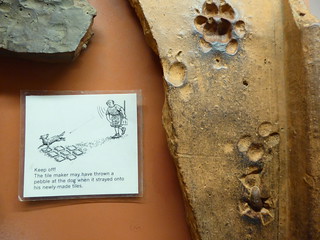 |
| Paw prints and a thrown stone? Did the potter throw the rock at the dog? |
Another day we took a train to St. Albans, not a UNESCO site, but like most of Europe, built on Roman ruins. On a walkabout, we came upon the Verulamium Museum and what a pleasant surprise. It's small, but very well curated, and full of treasures from Roman Verulamium and medieval St. Albans upon which the St. Albans of today is built. My sentimental favorites were the tile and potsherds with paw prints left by dogs when the clay was still wet, about a 1,000 years ago. Judging by the deep impression of this dog's paw, I'd say the drawing accompanying the sherd is pretty accurate.
 |
| Click to read St. Albans side of the story |
Wikipedia, generally my go-to site for unbiased information, let me down here. Their mention of Cardinal Wolsey's church reforms is shockingly different than the detailed account displayed on a wall inside St. Albans cathedral. There, in plain and bitter language, a much different tale is told.
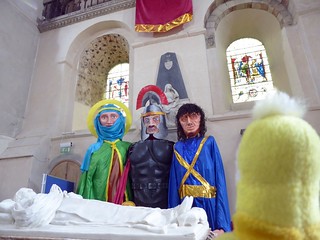 |
| Swami and some old acquaintances |
On the brighter side, the 800 year-old street market had the purse I've been looking months for and only £10. Plus Swami ran into some old acquaintances though I wasn't too sure about the middle guy.
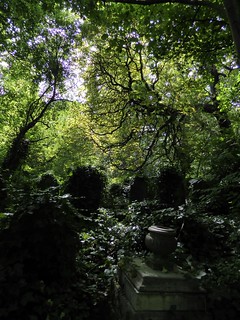 |
| Graves in the gloom |
We also spent an afternoon wandering around one of London's "Magnificent Seven" cemeteries, Abney Park. Opened in 1840, compared to the Romans, it's new but the graves are disappearing beneath a wilderness of nettles, blackberry bramble, ivy and trees right in the middle of London. It's deliciously forlorn. I loved it. M. Lee not so much.
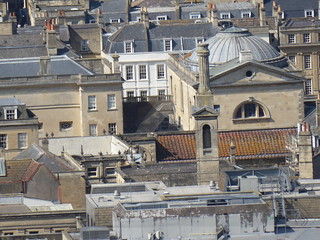 |
| Village of Bath the low, roofless building without a roof is the Roman baths |
And lastly we visited the village of Bath, so named for the thermal hot springs baths established there in the first century by, you know, the Romans. Except for the occasional newer home, Bath remains as it was rebuilt in the 18th century, a peaceful little Georgian village so, along with the Roman baths, the entire area is a World Heritage Site.
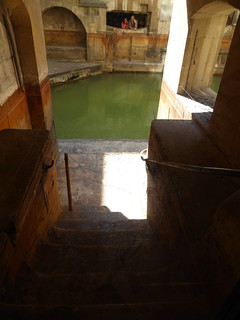 |
| Romans bath at Bath, one room among many |
Being such accomplished engineers, the Romans get credit for developing the springs although this was a sacred site for the Celts almost a thousand years earlier. But for all their Roman expertise, even at the sacred Bath, the occasional passing critter managed to leave a paw print or two in the tile.
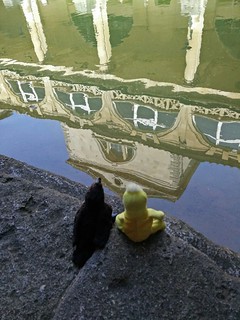 |
| Swami and Minerva enjoying a Roman bath |
The Verulamium Museum, St. Albans
And, of course, the brilliance of the capstone is that the arch needs no mortar yet will stand for a thousand years.

6 comments:
Very cool. It was not lost on me that your history lesson reached back at least, like, ten times farther than my explanation of the naming of Kansas City, Kansas, (and was proportionately more entertaining.) I enjoyed seeing the paw prints in the tile--looks like his claws needed trimming--and I'm afraid I rather liked the gloomy cemetery.
Who cares if Kansas isn't as old as Canterbury. In America we don't have history, we make history.
Btw, thanks a lot, as though I have nothing else to do, I won't say "better" because that is open to debate BUT..... your comment about the Roman dog need a nail trim got me reading the history of nail care this morning. Seems one form of nail clippers or another has been around for millennia though I suspect most Roman dogs didn't much benefit. Then, of course, Americans started patenting nail clippers and "new and improved" clippers in the 1800s.
I am delighted to hear you liked the photos from Abney Cemetery but not surprised as you are known for your highly refined sensibilities.
"as you are known for your highly refined sensibilities."
Fuk'n A, Bubba.
Would love to visit that cemetery. I've been to Bath and most enjoyed imagining the cultural shifts from Celtic to Roman as one pagan system of belief overtook another. Roman Britain has always appealed to me as a place of slow but continual change. And of course, for awhile, peace ( such as it could be in those days).
I think the cultural shifts are the best part of all this, and seeing how things live on, in altered forms.
If you like cemeteries, I'm sure you'd love this one. Of course, it's not in any way as significant, but it's weird like Chernobyl or the ruins of Detroit.
While I'm thinking of it, if, unlike me, you have time to read novels, I am working my way through a good one: The Historian, by Elizabeth Kostova. It is a vampire novel (I'm half way through) but the reason I mention it here is that it is very much like a travelogue. The main character is the daughter of an ambassador of sorts. They live in Amsterdam, but travel all over Europe, and notably, for the story, Istanbul. The descriptions are just this side of lavish, and very evocative and very good, and I suspect extremely accurate. I'm enjoying it quite a bit, in the same way I enjoy your blogotravologorama.
Post a Comment